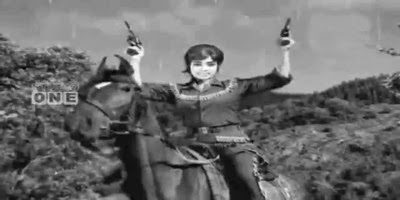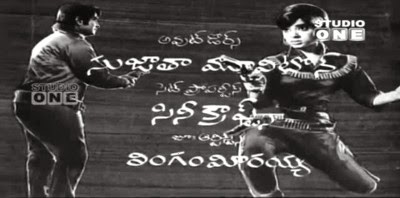Only the most enfeebled among you will be surprised to learn that contemporary relevance has nothing to do with why I choose to review a film on 4DK. Nonetheless, it is always interesting when some far flung obscurity that I’ve set my sights on turns out to have some. In the case of the 1971 Telegu actioner
Revolver Rani, that relevance comes from the fact that current Bollywood “it” girl Kangana Ranaut has chosen to star in a satirical remake of it as her follow up to this year's widely praised
Queen.
Those who are familiar with Telegu action films of
Revolver Rani’s particular bent -- we’ll call them “vengeful cowgirl” movies -- know that they are ripe for satire. Yet satire, at its best, needs a target that is earnest in intent, and
Revolver Rani leaves a lot of doubt as to just how seriously it takes itself. For instance, there is its title sequence, a riot of proto-
South Park cut out animation that sees a rapidly spinning Vijaya Lalitha picking off baddies like tin ducks in a carnival shooting range. It’s funny, but also captures perfectly the
feel of these movies: antic, breathlessly hyperbolic, and more than a little spastic.
And speaking of Vijaya Lalitha, a warning: those of you who, like me, come to
Revolver Rani hoping to see a showcase for that diminutive South Indian dynamo might at first feel like they’ve been the victim of a bait and switch. This is due to the unwritten rule (I’m assuming it’s unwritten, though perhaps it was inscribed on a banner above the studio gates) that Superstar Krishna and his hair had to appear in every Telegu film made. Krishna, I’m happy to say, only dominates the first half hour of
Revolver Rani and then, I’m even happier to say, is killed -- though, unfortunately, along with his dog, Peter, who showed a lot of promise as an anipal. This all occurs in the course of Krishna defending his sister, Lalitha’s Rani, from a rape attempt by the band of trigger happy grotesques he has fallen in with. Afterward, Rani -- thanks to Vijaya Lalitha’s unique features and command thereof -- adopts the look of a rabid Keane painting and swears her blood revenge, at which point
Revolver Rani becomes the kind of movie we like.
These hoodlums against whom Rani is now pitted, I want to point out, are led by a sharply dressed Mr. Big named Vikram, who suffers from a heart condition that causes him to erupt into violent coughing fits whenever he gets too worked up. As a signature disability for a villain to have, this falls somewhere below a hook hand or eye patch in terms of desirability, as it simply leaves the audience anticipating him conveniently dropping dead during a pivotal moment in the narrative (I’ll never tell).
Adding a nice
Magnificent Seven aspect to the typical “ride, rumble, shoot, then dance frenetically” structure of these films, Lalitha’s Rani decides that, to combat the gang, she must first form one of her own, and so rides off in search of suitable candidates. This she does to the accompaniment of the theme tune that music director Satyam has conjured up for her, which consists of basso male voices chanting the English word “vengeance” over a Morricone-esque backing. (By the way, Rani and her crew stay true to their rough riding cowpoke ways despite this film being set in the present day; there are cars and everything.) Rani first recruits a towering strongman for her cause, and then a carnival knife thrower. The vetting process basically involves Rani seeing the amount of grace with which they accept her beating the shit out of them. There’s a street boxer who doesn’t make the cut, but his high strung manager ends up tagging along for comic relief purposes. I think this is same actor to whom I referred in my review of
James Bond 777 as “Tollywood’s answer to Jagdeep”.
While there are many familiar faces both in front of and behind the camera in
Revolver Rani (many of whom I sadly can’t put names to) one of them is definitely not director
KSR Doss, the man behind so many of the Telegu films I’ve covered. Instead a character by the name of KVS Kutumba Rao is in the director’s chair, which affords me the opportunity to momentarily break from my Doss fixation and get some sense of which of the vengeful cowgirl movies’ quirks were specific to the genre, perhaps based on audience expectations, and were not a symptom of one director’s particular madness – to establish a base line for 1970s Telegu action cinema, so to speak.
And the fact is there is little to distinguish
Revolver Rani from one of Doss’ films in terms of pacing (frantic) or violence (also frantic -- and cartoonish), though the camera work does not quite approach Doss’ level of insane restlessness. There are also not quite so many of the upskirt shots that Doss was so fond of, though the one that I caught is pretty in your face. And by that I mean right up in there.
Vijaya Lalitha executed a flying scissor hold on my heart from the time I first saw her, in 1972’s
Kaun Saccha Kaun Jhoota, back in 2009, and there is nothing in
Revolver Rani that could chill my affections. Here the actress again exhibits that same peculiar combination of flitting, bird like movements and bug eyed intensity that, paired with the unrestrained mania of her fighting style – whether with whip, karate, or freestyle wrestling – makes her a signal figure in world action cinema. The only loss here is that we get to see little of Lalitha’s equally frenetic dancing, beyond a scene where she executes the old “infiltrate the villain’s hideout by posing as a nautch girl” gambit. The item girl duties are instead taken over admirably by the actress (Kavitha, perhaps?) who portrays Krishna’s nautch girl girlfriend, Lilly.
And then, of course, because no Telegu movie would be the same without her, Jyothi Laxmi shows up at the last minute for a number in which she demonstrates that sexy dancing and making really ugly faces are not mutually exclusive.
Once gathered, Rani and her gang go about the business of picking off Vikram’s rapey minions one by one while interfering with their various criminal enterprises (a diamond robbery in one case, sex trafficking in another). They then ship each minion’s corpse to their boss in a crate, complete with a nasty note. And, in case you were wondering, Rani does refer to herself as “Revolver Rani”. This activity attracts the attention of both Vikram and the Police Commissioner, who does nothing but listen to the latest tale of Rani’s exploits before staring dreamily off into the middle distance and repeating her name. All comes to a head in a showdown at Vikram’s lair that climaxes with Vijaya Lalitha wrestling a lion. And, yes, that is pretty fucking awesome.
Had I known those five years ago when I watched
Kaun Saccha Kaun Jhoota that there would turn out to be many, many movies like it, all of them starring Vijaya Lalitha and/or Jyothi Laxmi, I would have thought my life had become some kind of strange and wonderful dream. And still today, a film like
Revolver Rani sends me into an intoxicating reverie, a world very much like that film’s credit sequence, where a pixie-ish firebrand with Sailor Moon eyes spins like a dervish while sending greasily pompadoured, mustached men flying toward every point on the horizon, guns blazing and limbs a blur. True, the inclusion of two musclebound male sidekicks takes the action spotlight off of Vijaya Lalitha a little bit, but the fact that she fights alongside them as an equal (though they rescue her on occasion, she in turn rescues them) makes me respect her even more, and Telegu cinema as a whole for walking the walk.
Now the question: Will I see the remake? The
trailer for the film, predictably, shows us a Rani who’s much more dependent upon hardware and fire power than Lalitha’s version. Tell me that Kangana Ranaut wrestles a lion and we might be able to do business.





















































































